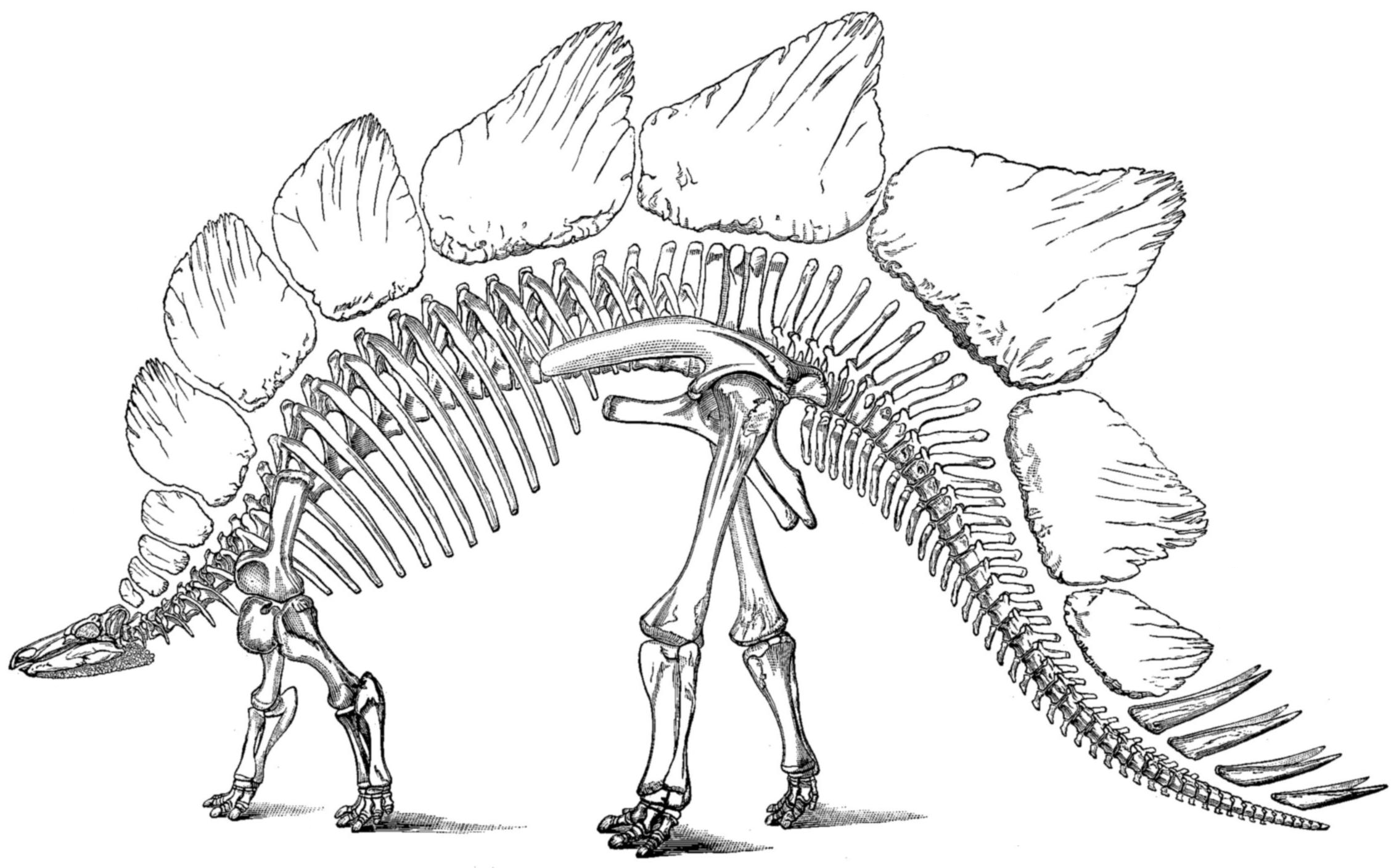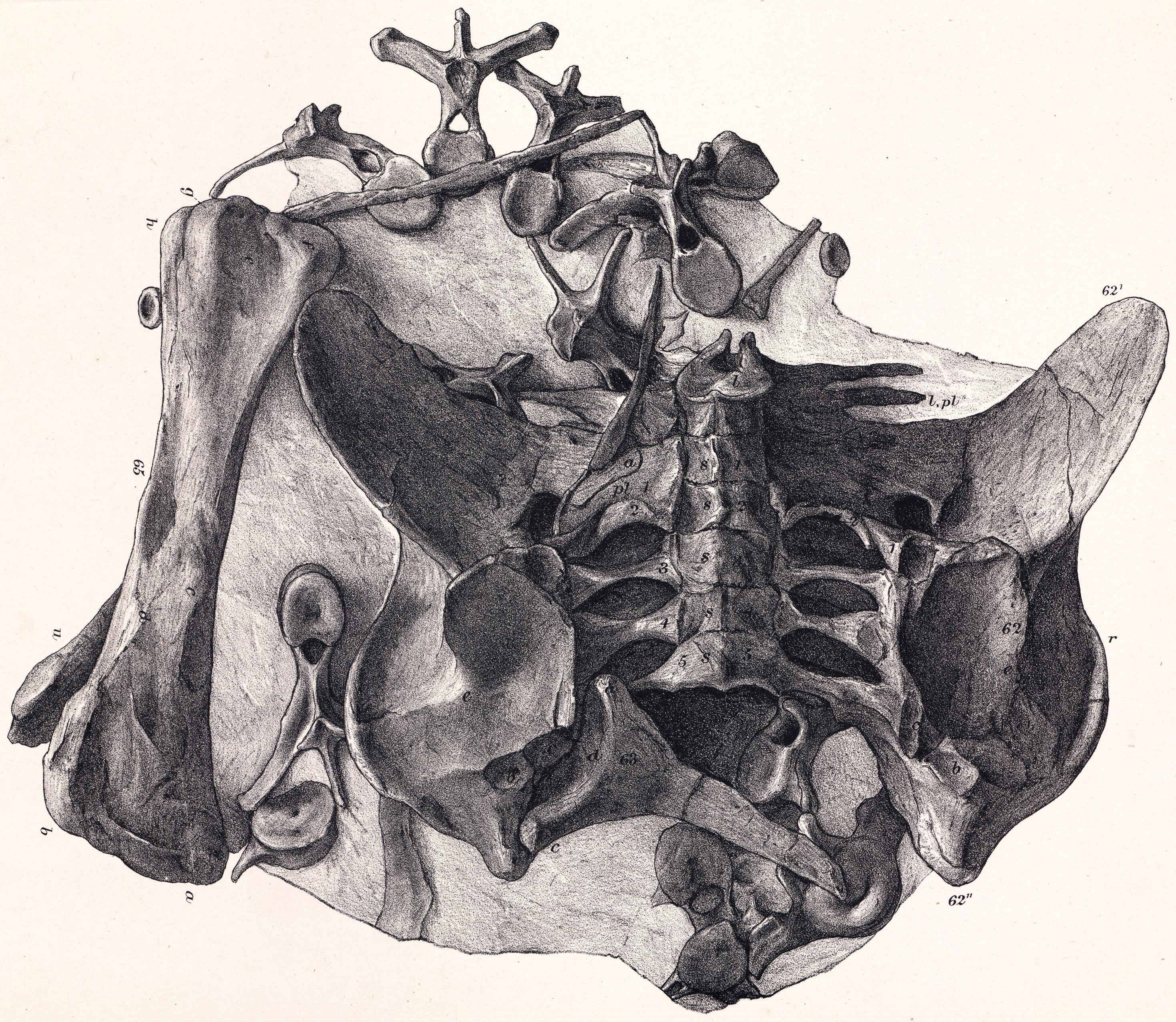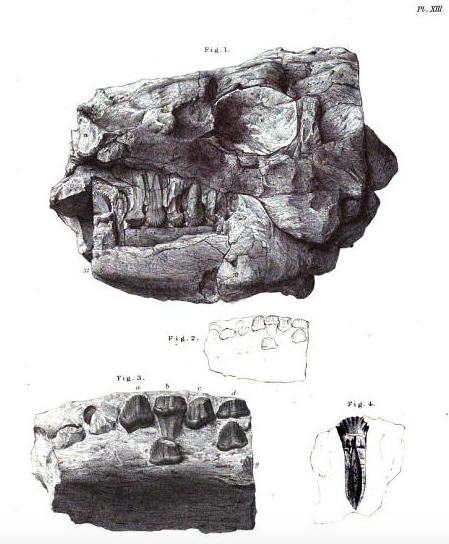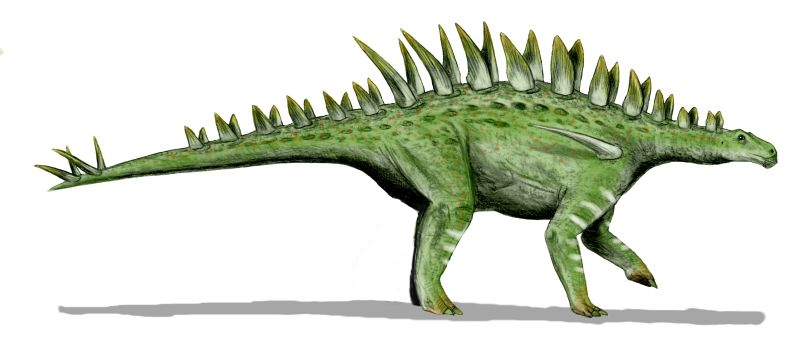|
Stegosaur
Stegosauria is a group of herbivorous ornithischian dinosaurs that lived during the Jurassic and early Cretaceous periods. Stegosaurian fossils have been found mostly in the Northern Hemisphere (North America, Europe and Asia), Africa and South America. Their geographical origins are unclear; the earliest unequivocal stegosaurian, '' Bashanosaurus primitivus'', was found in the Bathonian Shaximiao Formation of China. Stegosaurians were armored dinosaurs (thyreophorans). Originally, they did not differ much from more primitive members of that group, being small, low-slung, running animals protected by armored scutes. An early evolutionary innovation was the development of spikes as defensive weapons. Later species, belonging to a subgroup called the Stegosauridae, became larger, and developed long hindlimbs that no longer allowed them to run. This increased the importance of active defence by the thagomizer, which could ward off even large predators because the tail was in a highe ... [...More Info...] [...Related Items...] OR: [Wikipedia] [Google] [Baidu] |
Stegosaurus Ungulatus
''Stegosaurus'' (; ) is a genus of herbivorous, four-legged, armored dinosaur from the Late Jurassic, characterized by the distinctive kite-shaped upright osteoderm, plates along their backs and thagomizer, spikes on their tails. Fossils of the genus have been found in the western United States and in Portugal, where they are found in Kimmeridgian- to Tithonian-aged strata, dating to between 155 and 145 Mya (unit), million years ago. Of the species that have been classified in the upper Morrison Formation of the western US, only three are universally recognized: ''S. stenops'', ''S. ungulatus'' and ''S. sulcatus''. The remains of over 80 individual animals of this genus have been found. ''Stegosaurus'' would have lived alongside dinosaurs such as ''Apatosaurus'', ''Diplodocus'', ''Camarasaurus'' and ''Allosaurus'', the latter of which may have preyed on it. They were large, heavily built, herbivorous quadrupeds with rounded backs, short fore limbs, long hind limbs, and tai ... [...More Info...] [...Related Items...] OR: [Wikipedia] [Google] [Baidu] |
Kentrosaurus
''Kentrosaurus'' ( ; ) is a genus of stegosaurid dinosaur from the Late Jurassic in Lindi Region of Tanzania. The type species is ''K. aethiopicus'', named and described by German people, German Palaeontology, palaeontologist Edwin Hennig in 1915. Often thought to be a "Primitive (phylogenetics), primitive" member of the Stegosauria, several recent cladistic analyses find it as more derived than many other stegosaurs, and a close relative of ''Stegosaurus'' from the North American Morrison Formation within the Stegosauridae. Fossils of ''K. aethiopicus'' have been found only in the Tendaguru Formation, dated to the late Kimmeridgian and early Tithonian ages, about 152 annum, million years ago. Hundreds of bones were unearthed by German expeditions to German East Africa between 1909 and 1912. Although no complete skeletons are known, the remains provided a nearly complete picture of the build of the animal. In the Tendaguru Formation, it coexisted with a variety of dinosaurs such ... [...More Info...] [...Related Items...] OR: [Wikipedia] [Google] [Baidu] |
Bashanosaurus
''Bashanosaurus'' (meaning "Bashan lizard") is an extinct genus of stegosaurian dinosaur from the Middle Jurassic (Bathonian age) Shaximiao Formation of Yunyang County, China. The genus contains a single species, ''Bashanosaurus primitivus'', known from incomplete skeletons belonging to three individuals. It is one of the basalmost stegosaurs, as well as one of the oldest known stegosaurs, along with ''Adratiklit'', '' Isaberrysaura'', and '' Thyreosaurus''. Discovery and naming In 2016, a quarry of dinosaur fossils representing outcrops of the lower Shaximiao Formation was found in Laojun Village of Pu’an Township in Yunyang County, Chongqing Municipality, China. The ''Bashanosaurus'' fossil material was among the bones found in the outcrops, consisting of three specimens collected from the same horizon. The holotype specimen, CLGPR V00006-1, includes one dorsal and two caudal vertebrae, the right scapulocoracoid, a partial left hindlimb (femur, tibia, fibula, and a m ... [...More Info...] [...Related Items...] OR: [Wikipedia] [Google] [Baidu] |
Dacentrurus
''Dacentrurus'' (meaning "tail full of points"), originally known as ''Omosaurus'', is a genus of Stegosauria, stegosaurian dinosaur from the Late Jurassic and perhaps Early Cretaceous (154 - 140 mya (unit), mya) of Europe. Its type species, ''Omosaurus armatus'', was named in 1875, based on a skeleton found in a clay pit in the Kimmeridge Clay in Swindon, England. In 1902 the genus was renamed ''Dacentrurus'' because the name ''Omosaurus'' had already been used for a phytosaur. After 1875, half a dozen other species would be named but perhaps only ''Dacentrurus armatus'' is valid. ''Dacentrurus'' was the largest stegosaur measuring around long and weighing up to . Finds of this animal have been limited, so much of its appearance is uncertain and its relationship with other members of the Dacentrurinae are contentious. Some researchers suggest that ''Miragaia longicollum'' represents a junior synonym of this taxon. Discovery and species On 23 May 1874, James Shopland of the S ... [...More Info...] [...Related Items...] OR: [Wikipedia] [Google] [Baidu] |
Paranthodon
''Paranthodon'' ( ) is a genus of stegosaurian dinosaur that lived in what is now South Africa during the Early Cretaceous, between 139 and 131 million years ago. Discovered in 1845, it was one of the first stegosaurians found. Its only remains, a partial skull, isolated teeth, and fragments of vertebrae, were found in the Kirkwood Formation. British paleontologist Richard Owen initially identified the fragments as those of the pareiasaur '' Anthodon''. After remaining untouched for years in the British Museum of Natural History, the partial skull was identified by South African paleontologist Robert Broom as belonging to a different genus; he named the specimen '' Palaeoscincus africanus''. Several years later, Hungarian paleontologist Franz Nopcsa, unaware of Broom's new name, similarly concluded that it represented a new taxon, and named it ''Paranthodon owenii''. Since Nopcsa's species name was assigned after Broom's, and Broom did not assign a new genus, both names ar ... [...More Info...] [...Related Items...] OR: [Wikipedia] [Google] [Baidu] |
Baiyinosaurus
''Baiyinosaurus'' (meaning "Baiyin reptile") is an extinct genus of stegosaurian dinosaurs from the Middle Jurassic Wangjiashan Formation of China. The genus contains a Monotypic taxon, single species, ''B. baojiensis'', known from a partial skeleton including cranial bones. The skeletal anatomy of ''Baiyinosaurus'' demonstrates transitional features between Basal (phylogenetics), basal thyreophorans and stegosaurs. While many stegosaurs are known from China, ''Baiyinosaurus'' is the only one currently named from Gansu Province. Discovery and naming The ''Baiyinosaurus'' holotype specimen, Gansu Agricultural University, IVPG-D021, was discovered in 2016 by Li Daqing and his crew during excavations in sediments of the Wangjiashan Formation (Straw-yellow Sandstone Member). These outcrops are in the Pingchuan District of the city of Baiyin in Gansu Province, China. Following their discovery, the bones were collected and Fossil preparation, prepared by the Gansu Zhendan Dinosaur Cu ... [...More Info...] [...Related Items...] OR: [Wikipedia] [Google] [Baidu] |
Mongolostegus
''Mongolostegus'' (meaning "Mongolian roof") is an extinct genus of stegosaurian dinosaurs from the Early Cretaceous (Aptian–Albian ages) Dzunbain Formation of Mongolia. The genus contains a single species, ''Mongolostegus exspectabilis'', known from a fragmentary single specimen representing the first stegosaur named from Mongolia. It is one of the youngest known stegosaurs, along with '' Yanbeilong'' and an unnamed species from the Hekou Group of China. In contrast to these taxa, which are members of the late-diverging stegosaur subfamily Stegosaurinae, ''Mongolostegus'' may have affinities to more basal taxa such as the Huayangosauridae. Discovery and description The ''Mongolostegus'' holotype specimen, PIN 3779-15 was discovered in 1981 by a joint expedition between Soviet and Mongolian researchers. The specimen, recovered from a layer of the Dzunbain Formation at Chamrin-Us, Mongolia, comprises a single caudosacral vertebra articulated with the first five , a , the ... [...More Info...] [...Related Items...] OR: [Wikipedia] [Google] [Baidu] |
Alcovasaurus
''Alcovasaurus'' is an extinct genus of herbivorous stegosaurian dinosaurs that lived in the Late Jurassic. It was found in the Morrison Formation of Natrona County, Wyoming, Natrona County, Wyoming, United States. The genus contains a monotypic taxon, single species, ''Alcovasaurus longispinus'', originally assigned to the genus ''Stegosaurus''. It is likely a member of the Dacentrurinae, and has been referred to the genus ''Miragaia longicollum, Miragaia'' by some authors. Discovery and naming In July 1908, Professors William Harlow Reed and A.C. Dart of the University of Wyoming, in the Alcova Quarry in Natrona County, Wyoming, uncovered the skeleton of a stegosaurian. This would be the last major excavation of a dinosaur in which Reed was personally involved. In 1914, the find was named and described as ''Stegosaurus longispinus'' by Charles Whitney Gilmore on the basis of holotype UW 20503 (originally UW D54), a partial postcranial skeleton of an adult individual consisting ... [...More Info...] [...Related Items...] OR: [Wikipedia] [Google] [Baidu] |
Hesperosaurus
''Hesperosaurus'' (meaning "western lizard", from Classical Greek (') "western" and (') "lizard") is a herbivorous stegosaurian dinosaur from the Kimmeridgian age of the Jurassic period, approximately 156 million years ago. Fossils of ''Hesperosaurus'' have been found in the state of Wyoming and Montana in the United States of America since 1985. The type species ''Hesperosaurus mjosi'' was named in 2001. It is from an older part of the Morrison Formation, and so a little older than other Morrison stegosaurs. Several relatively complete skeletons of ''Hesperosaurus'' are known. One specimen preserves the first known impression of the horn sheath of a stegosaurian back plate. ''Hesperosaurus'' was a member of the Stegosauridae, quadrupedal plant-eaters protected by vertical bony plates and spikes. It was closely related to ''Stegosaurus'' and was similar to it in having two rows of, possibly alternating, plates on its back and four spikes on its tail end. The plates on its back ... [...More Info...] [...Related Items...] OR: [Wikipedia] [Google] [Baidu] |
Miragaia Longicollum
''Miragaia'' is a long-necked Stegosauria, stegosaurid dinosaur. Its fossils have been found in Upper Jurassic rocks in Portugal (Lourinhã Formation, Sobral Unit) and possibly also Wyoming, United States (Morrison Formation). ''Miragaia'' has the longest neck known for any stegosaurian, which included at least seventeen vertebrae. Some researchers consider this taxon to be a junior synonym of ''Dacentrurus''. History of discovery ''Miragaia'' is based on holotype Museu da Lourinhã, ML 433, a nearly complete anatomical terms of location, anterior half of a skeleton with partial skull (the first cranial material for a European stegosaurid). The remains were found after the construction of a road between the villages of Miragaia and Sobral de Monte Agraço Municipality, Sobral. The rear half of the skeleton was probably destroyed by the roadcut. The fossils were dug up in August 1999 and August 2001. Among the recovered bones were most of the snout, a right postorbital, bot ... [...More Info...] [...Related Items...] OR: [Wikipedia] [Google] [Baidu] |
Huayangosaurus
''Huayangosaurus'' is a genus of stegosaurian dinosaur from the Middle Jurassic of China. The name derives from "Huayang" (華陽), an alternate name for Sichuan (the province where it was discovered), and "saurus", meaning "lizard". It lived during the Bathonian to Callovian stages, around 165 million years ago, some 20 million years before its famous relative, ''Stegosaurus'' appeared in North America. At only approximately long, it was also much smaller than its famous cousin. Found in the Lower Shaximiao Formation, ''Huayangosaurus'' shared the local Middle Jurassic landscape with the sauropods ''Shunosaurus'', '' Datousaurus'', ''Omeisaurus'' and '' Protognathosaurus'', the ornithopod ''Xiaosaurus'' and the carnivorous '' Gasosaurus''. Description As with other stegosaurians, ''Huayangosaurus'' was a quadrupedal herbivore with a small skull and a spiked tail. Like ''Stegosaurus'', ''Huayangosaurus'' bore the distinctive double row of plates that characterize all the steg ... [...More Info...] [...Related Items...] OR: [Wikipedia] [Google] [Baidu] |
Jiangjunosaurus
''Jiangjunosaurus'' is an extinct genus of herbivorous stegosaurian dinosaurs from the Oxfordian-age (Upper Jurassic) Shishugou Formation of the Junggar Basin, Xinjiang, China. Discovery and naming In 2002, Liu Yongfei discovered the remains of a stegosaurian. These were secured by a Sino-American expedition and prepared by Xiang Lishi and Ding Xiaoqing. The type species, ''Jiangjunosaurus junggarensis'', was named and described by Jia Chengkai, Catherine Foster, Xu Xing and James Clark in 2007. The generic name refers to the abandoned town of Jiangjunmiao. ''Jiangjun'', 將 軍, is "general" in Chinese and the town's name, the "temple of the general", has been explained by the burial of one. The specific name refers to the provenance from the Junggar. The holotype, IVPP V 14724, was found in a layer of the Shishugou Formation, dating from the Oxfordian. It includes the lower jaws, some rear skull bones, eleven neck vertebrae, ribs, a scapula, a coracoid, and two neck plat ... [...More Info...] [...Related Items...] OR: [Wikipedia] [Google] [Baidu] |










